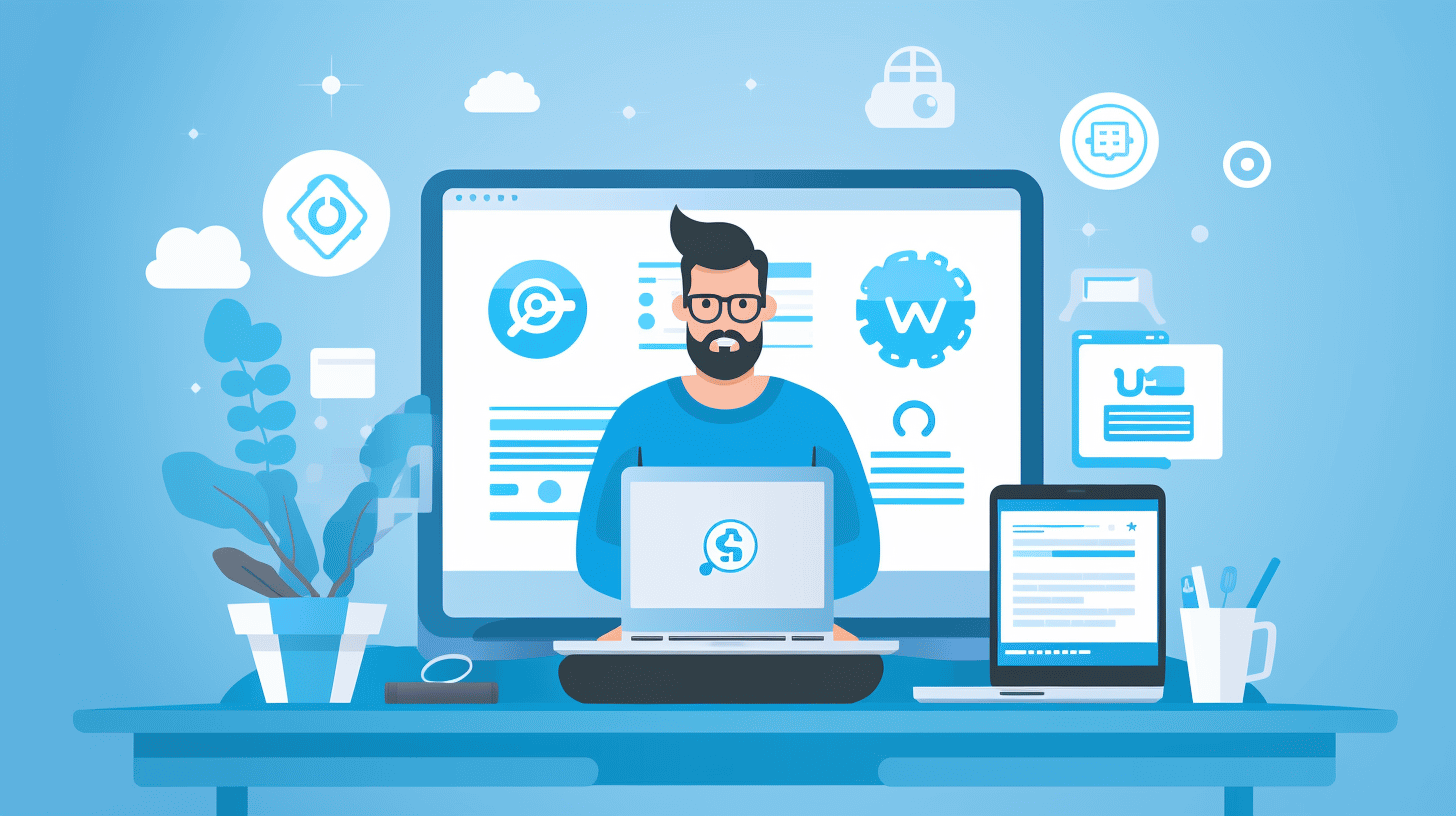在當今數位時代,網站安全比以往任何時候都更加重要。隨著網路威脅和攻擊變得越來越複雜,網站所有者必須採取主動措施來保護其寶貴的線上資產。無論您是初學者還是經驗豐富的 WordPress 用戶,掌握 WordPress 安全性對於確保您網站的安全性和完整性至關重要。
🔒🌐
在本綜合指南中,我們將探討 WordPress 安全的基本原理,並為您提供實用的技巧和技術來加強您網站的防禦能力。從了解常見的安全威脅到實施先進的安全措施,我們為您提供全方位服務。在本指南結束時,您將擁有工具和知識,可以自信地保護您的 WordPress 網站免受惡意攻擊。
🚀
讓我們深入研究並揭開掌握 WordPress 安全性的秘密!
了解 WordPress 安全基礎知識
保護您的 WordPress 網站對於保護您的資料、聲譽和訪客的體驗至關重要。隨著網路威脅的增加,制定強大的安全策略至關重要。在本文中,我們將探討網站安全為何重要以及 WordPress 網站面臨的常見安全威脅。讓我們開始吧!
網站安全的原因
確保 WordPress 網站的安全性至關重要,原因如下:
- 保護您的數據:您的網站包含敏感訊息,例如用戶資料、客戶詳細資訊和金融交易。安全漏洞可能導致資料被盜或遺失,從而危及您的業務和用戶。
- 維護你的聲譽:網站遭到駭客攻擊可能會損害您在訪客和客戶中的聲譽和信任。這會對您的品牌和信譽產生持久的影響。
- 避免法律後果:根據您的位置和您處理的資料類型,資料外洩可能會產生法律後果。遵守資料保護法規對於避免處罰至關重要。
- 維護網站效能:安全漏洞會影響您網站的效能,導致載入時間緩慢甚至網站崩潰。安全的網站可確保流暢的使用者體驗。
常見的安全威脅
由於 WordPress 網站使用廣泛且可能存在潛在漏洞,因此成為網路犯罪分子的熱門目標。讓我們來探討一下 WordPress 網站面臨的一些常見安全威脅:
- 暴力攻擊:駭客使用自動化工具系統地猜測使用者名稱和密碼,直到找到正確的組合以未經授權存取您的網站。
- 惡意軟體注入:惡意程式碼可以注入到您的網站的檔案、主題或外掛程式中,從而讓駭客控制和操縱您的網站。
- 過時的軟體:未能更新您的 WordPress 核心、主題和外掛程式會導致您的網站容易受到已知的安全漏洞的攻擊。定期更新對於修補安全漏洞至關重要。
- 不安全的登入憑證:弱密碼或重複使用密碼會增加未經授權存取您的網站的風險。此外,使用預設的「admin」使用者名稱會使駭客更容易攻擊您的網站。
為了減輕這些安全威脅,實施主動安全措施並遵循 WordPress 安全的最佳實踐至關重要。定期更新您的軟體、使用強大而獨特的密碼以及使用安全性外掛程式是增強 WordPress 網站安全性的一些步驟。請記住,對於網站安全來說,預防勝於治療!
在下一部分中,我們將探討一些實用的技巧和策略來增強您的 WordPress 網站的安全性。敬請關注!
🔒 使用這些 WordPress 安全提示確保您的網站安全!
設定WordPress安全措施
在當今的數位環境中,網站安全比以往任何時候都更加重要。隨著無數網路威脅迫在眉睫,採取主動措施保護您的 WordPress 網站免受潛在攻擊至關重要。透過實施強有力的安全措施,您可以保護您的網站,保護使用者資料並維護您的線上聲譽。在本節中,我們將探討設定 WordPress 安全措施的三個關鍵步驟。
🔒 設定強管理員憑證
任何 WordPress 網站的第一道防線都是強大且安全的管理員密碼。使用簡單且易於記憶的密碼很誘人,但這會使您的網站容易受到暴力攻擊。以下是建立強大管理員憑證的一些技巧:
- 使用大寫和小寫字母、數字和特殊字元的組合。
- 將您的密碼長度設定為至少 12 個字元以增加複雜性。
- 避免使用容易猜到的常用單字、片語或個人資訊。
- 考慮使用密碼管理工具來產生和儲存唯一的密碼,以實現最大程度的安全性。
請記住,管理員密碼的強度對於防止未經授權存取您的網站至關重要。花點時間設計一個強密碼,以阻止潛在的駭客。
🔄 定期更新的重要性
保持你的 WordPress 網站更新不僅僅是一個建議;這對於維護安全至關重要。更新通常包括解決已知漏洞的安全性修補程式和錯誤修復。忽視更新可能會使您的網站暴露於攻擊。定期更新至關重要的原因如下:
- 安全增強: 更新解決了駭客可能利用的漏洞,讓您的網站更能抵禦攻擊。
- 錯誤修復: 更新修復了可能導致意外行為或崩潰的錯誤和失誤。
- 相容性: 更新可確保您的網站與最新版本的 WordPress 外掛和主題相容。
為了隨時了解更新,請盡可能啟用 WordPress 核心、主題和外掛的自動更新。定期手動檢查更新,並在更新可用時立即套用。
💾 設定 WordPress 備份
無論您的安全措施有多強大,制定備份計劃都是至關重要的。備份您的 WordPress 網站可確保在出現安全漏洞、伺服器故障或任何其他不可預見的情況時您擁有所有資料的副本。這就是為什麼設定備份至關重要:
- 資料恢復: 如果發生違規或資料遺失,擁有備份可以讓您快速有效地還原您的網站。
- 安心: 知道您有最近的備份可以讓您安心,並允許您專注於網站管理的其他方面。
- 網站遷移: 將您的網站遷移到新的託管服務提供者或對您的網站進行重大更改時,備份至關重要。
要設定 WordPress 備份,您可以使用流行的插件,例如 UpdraftPlus、BackupBuddy 或 VaultPress。這些插件可讓您自動備份、安全地儲存它們並在需要時輕鬆還原您的網站。
透過遵循這些基本步驟 - 設定強大的管理員憑證、定期更新您的 WordPress 網站以及實施備份策略 - 您可以顯著增強您的 WordPress 網站的安全性。請記住,採取主動的安全措施是保護您的網站和確保用戶獲得無縫線上體驗的關鍵。保持警惕,注意安全!
WordPress 安全性插件
在當今的數位世界中,確保您的 WordPress 網站的安全比以往任何時候都更重要。隨著網路威脅的不斷增加,採取強有力的安全措施來保護您的網站免受潛在攻擊至關重要。增強 WordPress 網站安全性最有效的方法之一是使用安全性外掛程式。
識別最佳安全插件
由於市場上有大量的安全插件,因此確定哪些插件最適合您的網站可能具有挑戰性。但是,在確定最佳安全插件時需要考慮一些關鍵因素:
- 評級和評論: 檢查您正在考慮的插件的評級和評論。尋找具有其他用戶高評價和正面評價的插件。這是其有效性和可靠性的絕佳指標。
- 活躍安裝: 記下每個插件的有效安裝數量。活躍安裝數量越多表示該插件很受歡迎且被廣泛使用,這通常是一個好兆頭。
- 頻繁更新: 尋找由開發人員定期更新的插件。頻繁更新表明該插件得到積極維護並且潛在的安全漏洞正在及時解決。
- 相容性: 確保您選擇的安全外掛程式與您使用的 WordPress 版本相容。相容性問題可能導致衝突和不穩定,因此在安裝之前驗證相容性至關重要。
安裝並使用安全插件
一旦您確定了適合您的 WordPress 網站的最佳安全插件,下一步就是正確安裝和設定它們。以下逐步指南可協助您完成整個過程:
- 安裝插件: 登入您的 WordPress 儀表板並導航到「外掛」部分。點擊“新增”並蒐索您選擇的安全插件。找到後,按一下“立即安裝”,然後按一下“啟動”該外掛程式。
- 配置設定: 每個安全插件都有自己的設定面板,您可以在其中根據需要自訂安全功能。注意基本設置,例如登入保護、防火牆規則、惡意軟體掃描和封鎖可疑 IP 位址。
- 定期更新: 為您的安全插件設定自動更新,以確保您始終使用最新版本。開發人員經常發布更新來修補安全漏洞並增強插件的功能。
了解插件設定
了解安全插件的設定對於優化其有效性至關重要。以下是需要注意的一些基本功能和設定:
- 雙重認證: 啟用雙重認證,為您的 WordPress 登入流程新增額外的安全層。此功能要求使用者提供額外的驗證,例如唯一代碼或指紋,以及使用者名稱和密碼。
- 暴力保護: 啟動暴力破解保護以保護您的網站免於自動登入嘗試。此功能限制了來自相同 IP 位址的登入失敗嘗試次數,使得駭客難以獲得未經授權的存取。
- 防火牆規則: 利用防火牆規則在您的網站和潛在威脅之間建立屏障。這些規則可以阻止惡意 IP 位址,防止未經授權存取敏感文件,並過濾掉有害流量。
- 惡意軟體掃描: 啟用定期惡意軟體掃描以識別您網站上的任何惡意程式碼或檔案。此功能有助於檢測並消除潛在威脅,以免它們對您的網站及其訪客造成危害。
請記住,雖然安全外掛對於保護您的 WordPress 網站至關重要,但它們不應該是您唯一的防線。實施額外的安全措施(例如強密碼、定期備份以及保持 WordPress 核心和外掛程式為最新版本)至關重要。
透過選擇正確的安全性外掛程式、正確安裝它們並了解它們的設置,您可以顯著增強 WordPress 網站的安全性並保護其免受潛在威脅。因此,花點時間研究並投資最好的安全插件——這是一項從長遠來看會有回報的投資。注意安全!
高級 WordPress 安全措施
介紹
在當今的數位環境中,網站安全比以往任何時候都更加重要。作為 WordPress 用戶,採取主動措施保護您的網站免受潛在威脅和漏洞的侵害至關重要。雖然 WordPress 本身是一個安全的平台,但實施高級安全措施可以提供額外的保護以抵禦駭客和惡意攻擊。在本文中,我們將探討可實施的四種進階 WordPress 安全措施來保護您的網站。
實施雙重認證
增強 WordPress 網站安全性最有效的方法之一是實施雙重認證 (2FA)。此方法要求使用者除了提供使用者名稱和密碼之外,還需要提供額外的資訊(通常是驗證碼),從而為您的登入流程增加了一層額外的保護。這樣一來,即使攻擊者設法取得使用者的登入憑證,他們也無法在沒有第二個因素的情況下存取該帳戶。
如何在 WordPress 中啟用雙重認證
要在 WordPress 網站上啟用雙重認證,你可以使用以下可靠的外掛程式: 雙重因素。設定方法如下:
- 從 WordPress 外掛程式庫安裝並啟用 Two Factor 外掛程式。
- 導航至 使用者 在您的 WordPress 儀表板中。
- 選擇一個用戶並向下捲動到 雙因素期權 部分。
- 選擇所需的驗證方法(例如 Google Authenticator 或電子郵件)。
- 按照插件提供的說明完成設定。
啟用 SSL 安全
SSL(安全通訊端層)是一種在網站和訪客之間提供安全加密連線的協定。在您的 WordPress 網站上啟用 SSL 安全性至關重要,因為它可以保護用戶和您的網站之間交換的敏感信息,例如登入憑證和付款詳細信息。此外,SSL 現在被搜尋引擎視為排名訊號,這意味著它可以對您網站的 SEO 產生積極影響。
如何在 WordPress 網站上啟用 SSL
若要啟用 SSL 安全性,請依照下列步驟操作:
- 從受信任的憑證授權單位取得 SSL 憑證。
- 在您的 Web 伺服器上安裝 SSL 憑證。
- 將您的 WordPress 網站的 URL 從「http://」更新為「https://」。
- 安裝並啟用 真正簡單的 SSL 插件以確保您網站上的所有資源都安全加載。
保護你的 wp-config.php 文件
wp-config.php 檔案是 WordPress 安裝的關鍵元件,因為它包含敏感訊息,例如資料庫憑證、安全性金鑰和其他設定值。保護此文件對於保護您的網站免受未經授權的存取至關重要。
如何保護你的 wp-config.php 文件
若要保護您的 wp-config.php 文件,請遵循以下建議:
- 將 wp-config.php 檔案移到 public_html 資料夾以外的目錄。
- 使用檔案權限或透過伺服器的控制面板限制對 wp-config.php 檔案的存取。
- 從文件中刪除所有未使用的安全金鑰並將其保密。
- 定期監控文件是否有任何可疑的更改或未經授權的存取。
使用 Web 應用程式防火牆
實施 Web 應用程式防火牆 (WAF) 是保護您的 WordPress 網站的另一種強大的安全措施。 WAF 可以作為您的網站和潛在威脅之間的屏障,過濾掉惡意流量並在可疑請求到達您的網站之前封鎖它們。它透過分析傳入的請求並阻止表現出可疑行為的請求來增加額外的保護層。
如何在 WordPress 中使用 Web 應用程式防火牆
有幾種選項可用於將 Web 應用程式防火牆與 WordPress 整合。一個流行的選擇是使用 WordPress 安全性插件,例如 字柵欄,其中包括內建的 WAF。只需安裝並啟用插件,它將為您提供一系列安全功能,包括 WAF,以增強您的 WordPress 網站的安全性。
透過實施這些先進的安全措施,您可以大幅降低 WordPress 網站遭受網路攻擊的風險。請記住,維護一個安全的網站需要持續的關注和警惕,因此,務必隨時了解最新的安全最佳實踐並定期監控您的網站是否有任何潛在漏洞。
從 WordPress 安全漏洞中恢復
🔒 辨識違規跡象
發現你的 WordPress 網站已被入侵可能會是一個令人緊張和難以承受的經歷。然而,迅速果斷地採取行動以盡量減少損失並保護您網站的完整性至關重要。透過保持警覺和觀察,您可以識別一些常見的安全漏洞跡象:
- 異常網站行為:注意您網站上的任何意外或異常行為,例如載入時間緩慢、連結中斷或內容已未經授權更改。
- 可疑用戶帳戶:檢查您的 WordPress 使用者帳戶是否有任何陌生或可疑的使用者名稱或電子郵件地址。
- 不需要的彈出視窗或重定向:如果您發現彈出式廣告增加或您的網站將訪客重新導向到不相關的頁面,則可能表示存在入侵。
- 未經批准的插件安裝:留意您安裝的插件,確保沒有未經您的授權添加新的或未知的插件。
- 奇怪的資料庫條目:定期檢查您網站的資料庫,尋找可能因違規而產生的任何陌生或不尋常的條目。
如果您發現任何這些跡象,請務必立即採取行動來保護您的網站及其訪客。
👩💻 尋求專業協助
從 WordPress 安全漏洞中復原是一個複雜的過程,需要專業知識和技術知識。強烈建議尋求專業協助,以確保徹底、安全的復原。以下是專業協助至關重要的幾個原因:
- 專業知識和經驗:安全專業人員在處理安全漏洞方面擁有豐富的經驗,並且能夠快速評估損害程度。
- 全面的安全審計:專業人員可以進行徹底的安全審計,以識別漏洞並實施必要的安全措施,以防止將來發生違規行為。
- 高效能恢復:憑藉他們的知識和工具,專家可以有效地將您的網站恢復到漏洞之前的狀態,確保最短的停機時間。
- 持續支持:專業人員可以提供持續的支援和維護,以確保您的網站長期安全。
💾 從備份還原網站
從最近的備份還原您的網站是從安全漏洞中復原的重要步驟。它允許您將您的網站回滾到漏洞發生之前的已知安全狀態。使用備份還原網站的方法如下:
- 存取您的備份文件:找到您的網站備份文件,這些文件可能儲存在您的主機服務提供者的伺服器上或外部儲存位置。
- 建立受感染網站的備份:在進行復原之前,必須建立受感染網站檔案和資料庫的備份,以便在必要時進行進一步分析。
- 上傳並恢復備份:按照託管服務提供者或備份解決方案提供的說明,將備份檔案和資料庫上傳並還原到您網站的伺服器。
- 測試並驗證恢復:恢復過程完成後,請徹底測試並驗證您的網站,以確保所有功能和資料完好無損。
必須注意的是,定期備份對於有效的復原過程至關重要。優先考慮維護您的 WordPress 網站的強大備份策略。
🛡️ 違規後加強安全
從安全漏洞中恢復也應該起到警示作用,加強網站的安全措施。雖然沒有一個網站可以完全免受攻擊,但採取主動措施可以顯著降低風險。以下是一些需要實施的基本安全措施:
- 定期軟體更新:保持您的 WordPress 核心、主題和外掛程式為最新版本,以修補任何已知的安全漏洞。
- 強大而獨特的密碼:對所有使用者帳戶使用強而複雜的密碼,並考慮實施雙重認證以增強保護。
- 限制用戶訪問:僅向需要的受信任個人授予管理存取權限,並定期審查和刪除不必要的使用者帳戶。
- 安裝安全插件:利用信譽良好的安全性外掛程式為您的網站添加額外的保護層,例如惡意軟體掃描和防火牆保護。
- 定期安全掃描:設定定期安全掃描以偵測您網站上的任何潛在問題或漏洞。
透過實施這些安全措施,您可以顯著增強 WordPress 網站的安全性並降低未來違規的風險。
請記住,迅速採取行動、專業協助和主動的安全措施是從 WordPress 安全漏洞中恢復並保護您的網站免受未來威脅的關鍵。
WordPress 安全最佳實踐
WordPress 是最受歡迎的內容管理系統之一,為全球數百萬個網站提供支援。它的受歡迎程度也使其成為尋求利用漏洞的駭客的主要目標。因此,對於您的 WordPress 網站來說,優先考慮安全性至關重要。透過遵循一些最佳做法,您可以大大降低被駭客入侵的風險並保持您的網站順利運作。
🔒 強密碼實踐
增強 WordPress 安全性的最簡單但最有效的方法之一是確保強密碼實踐。弱密碼很容易被駭客猜測或破解,從而使您的網站面臨風險。以下是建立強密碼的一些重要提示:
- 使用大寫和小寫字母、數字和特殊字元的組合。
- 避免使用常用字或可預測的模式。
- 密碼長度至少為 12 個字元。
- 考慮使用密碼管理器來安全地產生和儲存您的密碼。
請記住,多個帳戶使用相同的密碼是大忌。如果一個帳戶被盜,您的所有其他帳戶也會面臨風險。花點時間為您的每個帳戶(包括您的 WordPress 管理員帳戶)建立和管理唯一的密碼。
👀 定期監控網站活動
密切注意您網站的活動可以幫助您儘早發現並解決任何潛在的安全威脅。定期監控可以讓您發現模式,識別可疑行為並採取必要的措施。以下是您應該考慮實施的一些監控措施:
- 安裝一個提供即時監控並向你發出任何可疑活動警報的安全插件。
- 定期檢查您的網站日誌,尋找任何未經授權存取或可疑 IP 位址的跡象。
- 監控使用者帳戶的異常行為,例如多次登入嘗試或暴力攻擊。
- 為關鍵事件(例如文件變更或登入嘗試失敗)設定電子郵件或文字通知。
透過積極監控您的網站,您可以在安全風險造成重大損害之前識別並減輕安全風險。
💡 有趣的事實:您知道嗎,所有 WordPress 漏洞中有 52% 都可以歸因於外掛?定期更新和刪除不必要的外掛程式可顯著降低安全漏洞的風險。
📰 隨時了解 WordPress 安全新聞
網路安全世界不斷發展,及時了解最新的 WordPress 安全新聞至關重要。保持知情,您可以了解新出現的威脅、安全修補程式以及專家推薦的最佳實踐。以下是一些保持聯繫的方法:
- 請關注 WordPress 安全部落格並訂閱其電子報以獲取定期更新。
- 加入 WordPress 安全論壇或社區,您可以向其他網站所有者和安全專家學習。
- 請關注官方 WordPress.org 部落格和社交媒體頻道,以了解重要公告和安全相關資訊。
透過保持知情,您可以採取主動措施來保護您的 WordPress 網站,並領先潛在威脅一步。
請記住,保護您的 WordPress 網站是一個持續的過程。透過遵循這些有關強密碼、定期監控和隨時了解情況的最佳實踐,您可以顯著降低安全漏洞的風險並確保您的網站安全無虞。
結論
總而言之,保護您的 WordPress 網站對於保護您的線上狀態和使用者的敏感資訊至關重要。透過實施本指南中討論的安全措施,您可以顯著降低安全漏洞的風險並確保您的網站擁有安全的數位環境。
請記住,WordPress 安全是一個持續的過程,需要不斷保持警惕並採取主動措施。了解最新的安全新聞並定期監控您網站的活動以識別任何潛在威脅。此外,遵循最佳做法(例如使用強密碼和定期備份您的網站)可以提供額外的保護。
雖然有許多可用的安全插件,但選擇正確的插件可以大大增強您網站的安全性。考慮利用 Managed-WP™(一種高級託管 WordPress 雲端託管平台)提供的值得信賴且可靠的安全解決方案。憑藉他們的專業知識和全天候支持,您可以放心,您的網站掌握在可靠的人手中。
使用 Managed-WP™ 保護您的網站、保障您的資料並確保您的訪客獲得安全的數位體驗。簡化您的基礎設施,讓專家處理您的 WordPress 安全需求。訪問 管理-wp.com 了解有關其全面託管解決方案的更多資訊。
請記住,在安全問題上,積極主動總是更好的選擇。不要等到安全漏洞發生後才採取行動。採取必要的預防措施來保護您的 WordPress 網站,並享受安全可靠的線上服務帶來的好處。
常見問題解答
- 在 WordPress 網站上需要實施哪些必要的安全措施?
為了增強您的 WordPress 網站的安全性,您應該:1. 保持 WordPress 核心、主題和外掛程式更新; 2. 對管理者帳號使用強大且獨特的密碼; 3.安裝信譽良好的安全插件; 4. 啟用雙重身分驗證登入; 5.使用安全的託管服務提供者; 6.定期備份您的網站。
- 推薦使用哪些安全性外掛程式來保護 WordPress 網站的安全?
一些流行的 WordPress 安全性外掛有:1. Wordfence; 2.Sucuri安全; 3.iThemes 安全; 4.一體化WP安全與防火牆; 5. 防彈安全。這些外掛程式提供各種安全功能並協助保護您的網站免受惡意攻擊。
- 影響 WordPress 網站的常見漏洞有哪些?
常見的漏洞包括過時的軟體、弱密碼、不安全的主題或外掛程式、易受攻擊的託管環境、惡意程式碼注入以及缺乏定期更新和備份。解決這些漏洞對於維護網站安全至關重要。
- 我的 WordPress 網站需要 SSL 憑證嗎?
是的,強烈建議您的 WordPress 網站擁有 SSL 憑證。它會對您的網站和訪客之間傳輸的資料進行加密,確保連線安全。它還有助於提高 SEO 排名並與受眾建立信任。
- 我應該多久備份一次我的 WordPress 網站?
建議每周至少備份一次您的 WordPress 網站。但是,備份的頻率可能會因您更新網站內容的頻率而有所不同。此外,建議進行異地備份以確保資料冗餘。



















